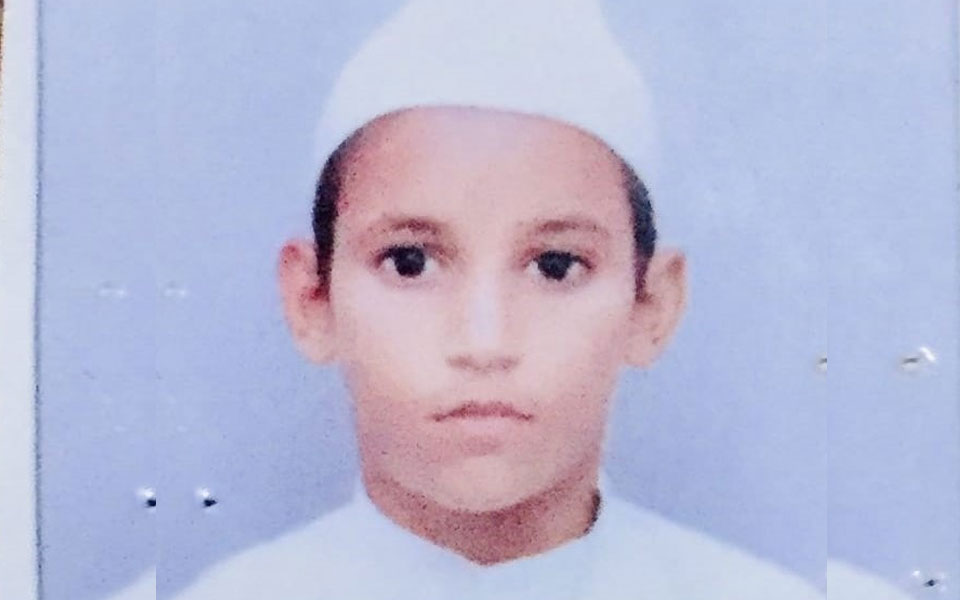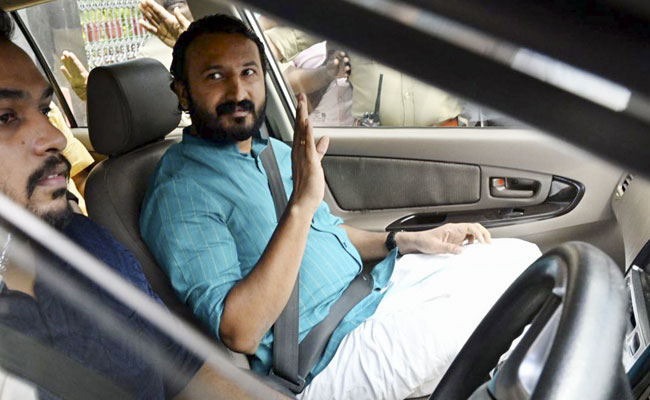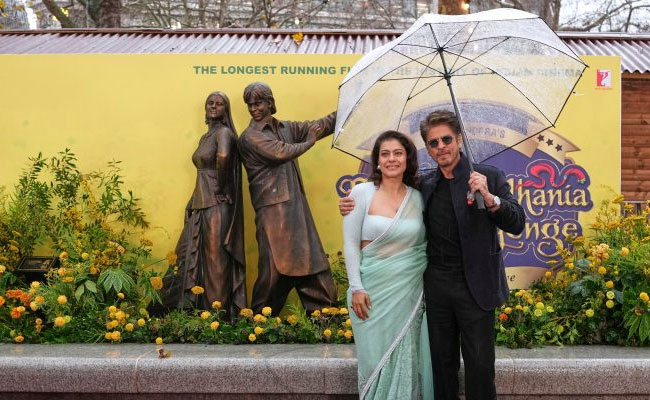Rumours were spinning out of control at South Delhi’s Jamia Faridiya Madrasa by Friday evening. So was the debate on social media. The death of eight-year-old Mohammad Azeem after a scuffle at the madrasa was spun as yet another mob lynching case—a hate crime where minors murdered a child.
Beyond the entire debate and the communal narrative, there was a father waiting for his son’s body. Mohammad Khaleel, a Nuh-Mewat resident, spent a few hours at the madrasa before leaving for AIIMS where his son’s body was kept for the post-mortem. Khaleel told Newslaundry he would leave for Nuh as soon as he receives his son’s body.
Here are the bare facts of what transpired on the morning of October 25. As recorded on the CCTV camera installed in the madrasa compound and told by three of Azeem’s friends, a scuffle broke out between two groups of children playing in the ground inside the madrasa compound. These were children from the madrasa and from the adjoining JJ Cluster, a jhuggi called Valmiki camp. During the scuffle, Azeem was pushed and thrown on a motorcycle nearby, and died. The person who picked up Azeem from the ground and placed his body at the mosque was from the Valmiki camp.
Was it a case of mob lynching? No. Those involved in the scuffle were all minors, probably of equal number on either side. Was there an exchange of communal abuse? Azeem’s friends said abuses were hurled at them but these were not communal in nature.

(The entrance to the masjid inside the Jamia Faridiya Madrasa compound.)
Heavy security has been deployed at the madrasa ever since the incident was reported. Four accused have been arrested by the police. All belong to the adjacent Valmiki camp. Newslaundry verified their ages: 12, 12, 13 and 13 years.
‘I have lost my youngest son here, can’t risk the lives of my two other sons’
“Wo kabhi jhut nahi bolta tha, (He used to never lie).” That’s how Azeem’s friend Mohammad Sahil remembers him.
A year and a half ago, Azeem joined his brothers—Mustakin,13, and Mustafa,11—at the Jamia Faridiya Madrasa located in South Delhi’s Begumpur area. Known as one the most disciplined among the students, he was taking Arabic and Urdu classes here. “Azeem ne Quran ke char para pure kar liye the (Azeem had completed four parts of the Quran),” remembers his brother Mustafa. While the elder brothers would wake up at 4 am, Azeem had the liberty to wake up by 5 am. Their classes started at different times and later, they would take care of individual daily chores.
Thursday, October 25, was a holiday. Mustafa and Mustakin had gone to Hauz Rani locality with all the other older students. A group of younger students stayed behind in the Madrasa. Mustafa told Newslaundry, “Azeem jaise chhote bache sadak paar nahi kar sakte isliye wo yahin ruke the (As small kids like Azeem can’t cross the roads, they stayed back.)”
Jamia Faridiya Madrasa is located right next to the fort in Begumpur. The compound still has the ruins of the fort area. The lane connects to the main road and is surrounded by JJ clusters on two sides. Inside the compound is a hostel, the masjid and a small garden and a building where officials stay. One of the sides has the plot which also opens into the Valmiki camp. The Valmiki camp is surrounded by two more JJ clusters.
Azeem along with Mohammad Faizan, Sahil and Mohammad Asif was playing gilli danda in the Mazaar area. Faizan, a resident of Patna’s Mohiuddinpur, had joined the madrasa after Bakra-Eid this year and is the eldest of the group. Another bunch of children from the jhuggi were also playing in the field there. Sahil said, “While playing, our gilli went in their direction. When we asked for it, they (the attackers) refused to do so and started abusing us.”

(Azeem’s three friends—Md Faizan, Md Sahil and Md Asif who present when the incident happened.)
Faizan said, “I told them not to do so, bhai yaar maan ja. The children from the jhuggi didn’t stop and started pelting stones at us. When we again asked them to stop, they started the scuffle.” He said the group of kids from the Valmiki camp, while bursting crackers, also threw bombs at them. Asif showed Newslaundry the mark of one such cracker which had hit him on the ankle on Thursday.
He added that one of the attackers—Newslaundry is holding back the identity of the accused as they are being tried under the juvenile justice law—“pushed Azeem on a bike”. These children claim that despite Azeem falling on the ground, the children from the Valmiki camp did not stop hitting him and even climbed onto his chest.
The CCTV footage shows the two groups of children playing. The children in white are from the madrasa and the others are from the jhuggi. One of the madrasa students can be seen hitting a child from the jhuggi and they start fighting. Azeem is the youngest and waits on the Mazar wall, watching. He eventually enters the scuffle, possibly to stop the fighting groups. Barely seconds later, he is pushed and falls on a motorcycle parked there. The incident happened at 10.06 am.
(This video sourced by Newslaundry shows the footage of the CCTV installed in the Madrasa compound.)
Azeem was rushed to the Madan Mohan Malviya Hospital. The caretaker of the madrasa, 62-year-old Mohammad Ali Jauhar, told Newslaundry Azeem was declared brought dead. Another resident of the madrasa, Mohammad Mukim, who took Azeem to the hospital, said, “It seems he probably died here itself, in our arms. However, the doctors did try to revive and check him for more than an hour. We finally informed his parents about his death.”
Meanwhile, for Azeem’s father Mohammad Khaleel, there is nothing left in Delhi. “I lost my son here, I can’t risk the lives of other two sons,” he said. “I am afraid about the security of both my sons and will take them back to Mewat today itself. They too are scared.” All he demands is justice and said he has hope from “AAP and Delhi Chief Minister Arvind Kejriwal”. However, the police in Delhi comes under the Central government.
The madrasa organised a Namaz-e-Janaza for Azeem. Aam Aadmi Party lawmakers Somnath Bharti and Amanatullah Khan were both present at the meeting held at the Madrasa. The gathering put forward a demand for compensation for the family and Bharti assured them it would happen.
The accused
Friday prayers began and the crowds brought a frenzy with them. There were outsiders, politicians and even advocates who came in solidarity. Each had a different version of the story to tell, and the common thread in their narratives was the mob lynching angle. It was repeated over and over again—that the accused who hit Azeem were older kids and did so in hatred.
Three of Azeem’s friends confirmed the names of two of the accused to Newslaundry, and we verified their ages from their identity proofs.
K is 12 years old. His sister showed Newslaundry K’s Aadhaar card which lists his year of birth as 2006. His sister said their parents are still at the police station, and she’s worried about the security of her brother.
A few metres away, in the extremely narrow lanes of Valmiki colony, is D’s house. His brother, a Class 9 drop-out, told Newslaundry that D is either 12 or 13—D is younger than his brother and sister who are 15 and 14 years old, respectively. D’s brother said, “He studies in Class 8 in the government school in Malviya Nagar. These are common fights. Even I had a scuffle with these madrasa kids last Diwali. They beat us when we go to play there.” D’s parents were also at the police station.
A short distance away, Newslaundry met S’s two older brothers. After a search of about 15 minutes, they showed this correspondent S’s Aadhaar card which says he was born in 2005.
In another lane, Rajkumar Paswan, a native of Bihar, waits for his son T’s return. “The last time I met my son was on Thursday, around 11 or 12 in the night.” He showed this correspondent his son’s Aadhaar card. T is 12 years old. His father says, “The madrasa guys had first held our son. We brought him back. Later, we (the parents of accused) were informed that we need to take our sons to the police station.” T was arrested at the police station itself.
“My son said he didn’t fight but had attempted to stop the scuffle.” When asked about the talks of lynching, Rajkumar said, “Bacchon aapas mein ladte jhagadte rehte hain. Humare bache wahin khelte the aur ladai hoti thi(Fights do happen between children. Our kids used to play there and these fights were not new).”
As all accused in the case are minors, they will be sent to juvenile homes.
The tension between the madrasa and Valmiki camp
Given the location of the Valmiki camp and the madrasa, the path which opens into the Madrasa gives the residents of Valmiki camp comparatively easier access to the main road. But that’s the root cause of the tussle.
“It’s not a path meant for common use. It is part of the madrasa compound and it’s our place of worship,” said Maulana Ali, the maulana of the madrasa. “Drunkards and drug addicts pass through the masjid, they play satta(gambling) here. How can we allow such activities inside our place of worship?”

(The plot where the incident happened which connects Valmiki camp and the madrasa.)
Maulana and his associates said that on Friday morning, someone called Bunty from Valmiki camp threatened them, saying, “We will kill more people now.” They say a woman called Saroj from the camp is behind the trouble being triggered between the residents of the madrasa and the jhuggi.
The madrasa management and those frequenting the masjid have several complaints about the Valmiki campresidents. “Last year, empty liquor bottles were thrown inside the masjid when Jammat had come. It’s thanks to Allah that no one was injured,” said Mohammad Ali Jauhar, the caretaker of the madrasa.
Advocate Shakeel Akhtar showed Newslaundry the magistrate order which says the madrasa authorities can build a wall to stop the unauthorised use of the land as a passage or path. Akhtar said, “The police should have ensured the building of the wall.” In fact, the spirited mob once decided to build the wall right away, to end the friction between them and the people from the jhuggi. However, elders asked them “not to take law in their [own] hands”.
The madrasa authorities and local Muslims say there have been several attempts by Valmiki camp residents to create an atmosphere of hostility. Maulana said, “This is a Wakf property. Why would you burn a Raavan inside our compound? Taking a taazia (procession) to a temple would mean wilfully disrupting the peace.”
But now we come to the other side of the story. The residents of Valmiki camp don’t deny several events brought up by the Madrasa authorities—using the path and the plot, and the Raavan effigy incident which happened this year. Mohammad Shehjad, 22, who belongs to one of the five Muslim families living in the jhuggi, explained, “We didn’t burn the effigy inside the masjid. But yes, we did keep the Raavan’s parts inside the compound before Dussehra, as the children didn’t have any other place to store it.”
Residents of Valmiki camp say the area serves many purposes—a path, parking at times, a playground for children, a hangout zone for youth and also an emergency exit. They also have their own complaints. “The masjid people beat up our children. And often create trouble for us,” 42-year-old resident Ajay said.
Liyaqat Ali Saroj—the woman whom Maulana Ali said was behind the tension—does wield control over a certain section of the community. She belongs to the minority community and says the allegations against her are false. “In fact, my own son was attacked in the plot recently,” she says. “We don’t have any other land even for parking. If there is an earthquake, that is the fastest exit for us. Should we be left here to die?”
Women argue that the land is government property and any attempt to block would deny them easy access to the main road. Interestingly, even Madrasa students such as Azeem’s friend Mohammad Sahil, use the path to enter the jhuggi to buy groceries for daily use.
Kamala, another resident, said, “The madrasa guys file a complaint or blame anyone who fights for the jhuggiwallahs.” Her son Bunty was the one accused of threatening the madrasa residents. “They are hardly concerned about the child’s death and are more interested in the plot they have occupied. Why do they want to build a wall today when the child has died? ”
Meanwhile, during the Namaz, announcements were made from the masjid saying that Azeem's death was like several attacks on Muslims happening across the country. Shehjad and Saroj both complain that these announcements will help no one. Saroj said, “If tomorrow all the Hindus living in the jhuggi started believing the same, what will the few Muslim families do? Where will we go?”
courtesy : newslaundry.com
Let the Truth be known. If you read VB and like VB, please be a VB Supporter and Help us deliver the Truth to one and all.
Thiruvananthapuram (PTI): A Special Investigation Team (SIT) has been constituted to probe a second case of sexual assault against expelled Congress MLA Rahul Mamkootathil, police officials said on Friday.
The SIT will be led by G Poonguzhali, Assistant Inspector General at the Police Headquarters.
The team also includes a DSP rank officer and sub-inspectors, officials added.
The second sexual assault complaint was received by the Kerala Pradesh Congress Committee, which it forwarded to the state police chief.
ALSO READ: Cong expels rape-accused MLA Mamkootathil from party's primary membership
Following this, the Crime Branch registered a case and launched an investigation.
Crime Branch officials said the email complaint contained only the sender's email ID and no other contact details.
As part of the probe, they have sent a reply email requesting that the complainant contact them and provide her statement.
The complainant has alleged that she was sexually assaulted under the false promise of marriage, a Crime Branch official said.
However, details such as the location and date of the alleged incident are not currently available to the police.
The SIT will attempt to trace the sender of the email and record her statement, which is crucial for further investigation, the officer said.
Mamkootathil was expelled from the Congress party on Thursday after a court here rejected his anticipatory bail petition in another rape case.
Police said he is currently absconding, and a manhunt is underway in Kerala and neighbouring states.





